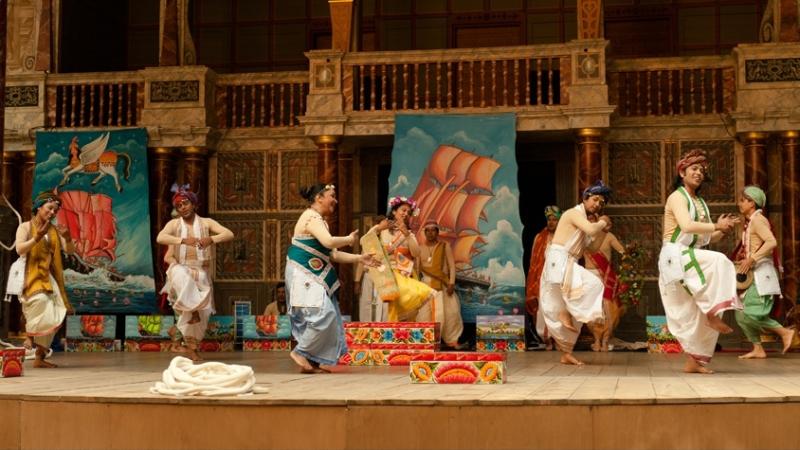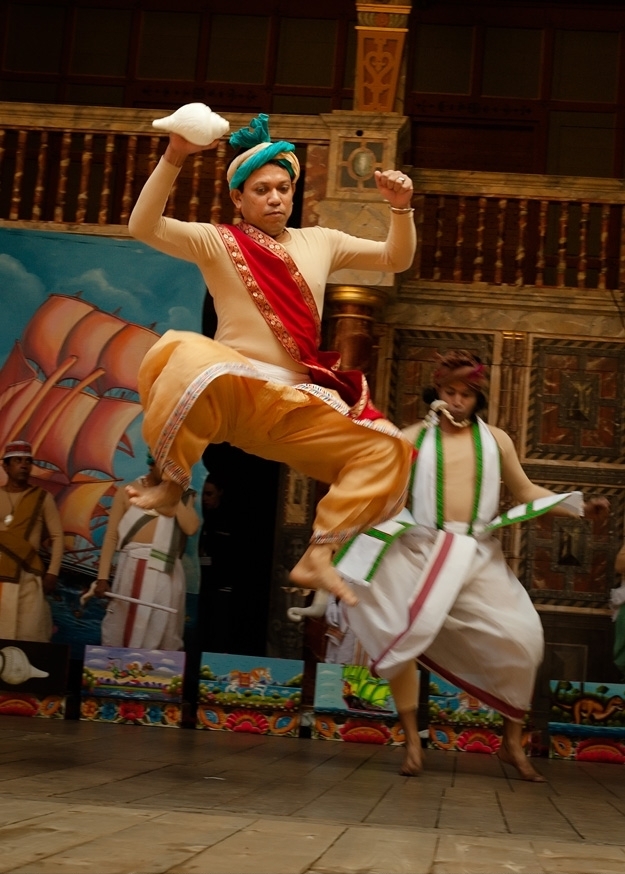Globe to Globe: The Tempest, Shakespeare's Globe | reviews, news & interviews
Globe to Globe: The Tempest, Shakespeare's Globe
Globe to Globe: The Tempest, Shakespeare's Globe
Post-colonial high-energy singing and dancing for the Bard's last play

This music crept by me on the waters. Bangladesh’s Dhaka Theatre’s version of The Tempest took the musical route, and why not? It was always Shakespeare’s most musical play (with extant music for “Full Fathom Five” and other songs written by Robert Johnson).
The adaptation included snippets of well-known Bengali folk tunes – drinking songs for Stephano, wedding tunes and so on. The exotic element even for Bengalis came with a couple of Manipuri drummers, spirits who somersaulted with their drums. Ariel was covered in blue gauze and played by Shimul Youssef with a terrific voice singing high classical alaaps, which was a useful counterpoint to all the rhythmic energy.
Prospero moved around like a crane moving slowly on hot coals
This was, more than anything, a good-natured production. You never felt the characters were in jeopardy – this was a resilient rather than a demure Miranda, Caliban was a hail-fellow-well-met sort, and Prospero did not particularly emanate mystery or power. This was all partly because of the production’s semi-successful attempt to use gestures and stylised movements to signify character. In the case of Prospero, played likeably by Rubol Noor Lodi, he moved around like a crane proceeding slowly on hot coals, which rather undermined his air of authority.
 The knock-about slapstick of Trinculo certainly amused the audience, about a third of whom were Bengalis. But heavy stress laid on the musical and physical meant it worked for us non-Bengali speakers too, even if we missed out on the translated cadences of Shakespeare’s last, most profoundly poetic play.
The knock-about slapstick of Trinculo certainly amused the audience, about a third of whom were Bengalis. But heavy stress laid on the musical and physical meant it worked for us non-Bengali speakers too, even if we missed out on the translated cadences of Shakespeare’s last, most profoundly poetic play.
The leaping into song at any prompt gave this Tempest a Bollywood flavour, as did the romance-in-danger and happy ending. I’ve sometimes thought that Shakespeare might nowadays be writing Bollywood movies with all their family feuds and mistaken identities. You could certainly imagine a version of this production working on film even if the dancing here was a little amateurish - disconcertingly so until you got used to the idea that Miranda's, for example, lent the character an untutored innocence. After all, she hadn’t spent her life in dancing academies.
If the emotional resonances of the play seemed muted in the first half, the scenes of forgiveness, the renunciation of Prospero and the marriage of Miranda and Ferdinand did bring some spiritual depth. But here the climactic moments featured the liberation of Ariel, who danced and laughed for joy, and, even more so, Caliban on a makeshift throne, blowing a conch, all deformity gone. This was a post-colonial reading of the play, in which freedom from oppression by the magic-wielding colonialists gave rise to hope.
This music crept by me on the waters. Leaving the theatre, with the Globe at my back and Blackfriars and St Pauls in front, a busker played a flute as I crossed the river.
Share this article
The future of Arts Journalism
You can stop theartsdesk.com closing!
We urgently need financing to survive. Our fundraising drive has thus far raised £49,000 but we need to reach £100,000 or we will be forced to close. Please contribute here: https://gofund.me/c3f6033d
And if you can forward this information to anyone who might assist, we’d be grateful.

Subscribe to theartsdesk.com
Thank you for continuing to read our work on theartsdesk.com. For unlimited access to every article in its entirety, including our archive of more than 15,000 pieces, we're asking for £5 per month or £40 per year. We feel it's a very good deal, and hope you do too.
To take a subscription now simply click here.
And if you're looking for that extra gift for a friend or family member, why not treat them to a theartsdesk.com gift subscription?
more Theatre
 Mary Page Marlowe, Old Vic review - a starry portrait of a splintered life
Tracy Letts's Off Broadway play makes a shimmeringly powerful London debut
Mary Page Marlowe, Old Vic review - a starry portrait of a splintered life
Tracy Letts's Off Broadway play makes a shimmeringly powerful London debut
 Little Brother, Soho Theatre review - light, bright but emotionally true
This Verity Bargate Award-winning dramedy is entertaining as well as thought provoking
Little Brother, Soho Theatre review - light, bright but emotionally true
This Verity Bargate Award-winning dramedy is entertaining as well as thought provoking
 The Unbelievers, Royal Court Theatre - grimly compelling, powerfully performed
Nick Payne's new play is amongst his best
The Unbelievers, Royal Court Theatre - grimly compelling, powerfully performed
Nick Payne's new play is amongst his best
 The Maids, Donmar Warehouse review - vibrant cast lost in a spectacular-looking fever dream
Kip Williams revises Genet, with little gained in the update except eye-popping visuals
The Maids, Donmar Warehouse review - vibrant cast lost in a spectacular-looking fever dream
Kip Williams revises Genet, with little gained in the update except eye-popping visuals
 Ragdoll, Jermyn Street Theatre review - compelling and emotionally truthful
Katherine Moar returns with a Patty Hearst-inspired follow up to her debut hit 'Farm Hall'
Ragdoll, Jermyn Street Theatre review - compelling and emotionally truthful
Katherine Moar returns with a Patty Hearst-inspired follow up to her debut hit 'Farm Hall'
 Troilus and Cressida, Globe Theatre review - a 'problem play' with added problems
Raucous and carnivalesque, but also ugly and incomprehensible
Troilus and Cressida, Globe Theatre review - a 'problem play' with added problems
Raucous and carnivalesque, but also ugly and incomprehensible
 Clarkston, Trafalgar Theatre review - two lads on a road to nowhere
Netflix star, Joe Locke, is the selling point of a production that needs one
Clarkston, Trafalgar Theatre review - two lads on a road to nowhere
Netflix star, Joe Locke, is the selling point of a production that needs one
 Ghost Stories, Peacock Theatre review - spirited staging but short on scares
Impressive spectacle saves an ageing show in an unsuitable venue
Ghost Stories, Peacock Theatre review - spirited staging but short on scares
Impressive spectacle saves an ageing show in an unsuitable venue
 Hamlet, National Theatre review - turning tragedy to comedy is no joke
Hiran Abeyeskera’s childlike prince falls flat in a mixed production
Hamlet, National Theatre review - turning tragedy to comedy is no joke
Hiran Abeyeskera’s childlike prince falls flat in a mixed production
 Rohtko, Barbican review - postmodern meditation on fake and authentic art is less than the sum of its parts
Łukasz Twarkowski's production dazzles without illuminating
Rohtko, Barbican review - postmodern meditation on fake and authentic art is less than the sum of its parts
Łukasz Twarkowski's production dazzles without illuminating
 Lee, Park Theatre review - Lee Krasner looks back on her life as an artist
Informative and interesting, the play's format limits its potential
Lee, Park Theatre review - Lee Krasner looks back on her life as an artist
Informative and interesting, the play's format limits its potential
 Measure for Measure, RSC, Stratford review - 'problem play' has no problem with relevance
Shakespeare, in this adaptation, is at his most perceptive
Measure for Measure, RSC, Stratford review - 'problem play' has no problem with relevance
Shakespeare, in this adaptation, is at his most perceptive

Add comment